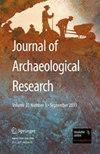“Every Tradesman Must Also Be a Merchant”: Behavioral Ecology and Household-Level Production for Barter and Trade in Premodern Economies
IF 4.1
1区 历史学
Q1 ANTHROPOLOGY
引用次数: 0
Abstract
While archaeologists now have demonstrated that barter and trade of material commodities began in prehistory, theoretical efforts to explain these findings are just beginning. We adapt the central place foraging model from behavioral ecology and the missing-market model from development economics to investigate conditions favoring the origins of household-level production for barter and trade in premodern economies. Interhousehold exchange is constrained by production, travel and transportation, and transaction costs; however, we predict that barter and trade become more likely as the number and effect of the following factors grow in importance: (1) local environmental heterogeneity differentiates households by production advantages; (2) preexisting social mechanisms minimize transaction costs; (3) commodities have low demand elasticity; (4) family size, gender role differentiation, or seasonal restrictions on household production lessen opportunity costs to participate in exchange; (5) travel and transportation costs are low; and (6) exchange opportunities entail commodities that also can function as money. Population density is not a direct cause of exchange but is implicated inasmuch as most of the factors we identify as causal at the household level become more salient as population density increases. We review archaeological, ethnohistoric, and ethnographic evidence for premodern marketing, observing that the model assumptions, variables, and predictions generally receive preliminary support. Overall, we argue that case study and comparative investigation of the origins of marketing will benefit from explicit modeling within the framework of evolutionary anthropology."每个商人都必须是商人":前现代经济中易货贸易和贸易的行为生态学与家庭层面的生产
虽然考古学家现在已经证明物质商品的易货贸易和贸易始于史前,但解释这些发现的理论工作才刚刚开始。我们调整了行为生态学中的中心地觅食模型和发展经济学中的缺失市场模型,研究了有利于前现代经济中以物易物和贸易的家庭生产起源的条件。家庭间的交换受到生产、旅行和运输以及交易成本的限制;然而,我们预测,随着以下因素的数量和影响越来越重要,以物易物和贸易变得更有可能:(1)当地环境的异质性使家庭因生产优势而不同;(2)已有的社会机制将交易成本降至最低;(3)商品的需求弹性较低;(4)家庭规模、性别角色差异或家庭生产的季节性限制降低了参与交换的机会成本;(5)旅行和运输成本较低;(6)交换机会涉及的商品也可充当货币。人口密度并不是交换的直接原因,但由于我们在家庭层面发现的大多数因果因素都会随着人口密度的增加而变得更加突出,因此人口密度也与交换有关。我们回顾了前现代市场营销的考古学、人种史学和人种学证据,发现模型假设、变量和预测一般都得到了初步支持。总之,我们认为,在进化人类学的框架内建立明确的模型将有利于对营销起源进行案例研究和比较调查。
本文章由计算机程序翻译,如有差异,请以英文原文为准。
求助全文
约1分钟内获得全文
求助全文
来源期刊

Journal of Archaeological Research
Multiple-
CiteScore
10.20
自引率
7.90%
发文量
9
期刊介绍:
Journal of Archaeological Research publishes the most recent international research summaries on a broad range of topics and geographical areas. The articles are intended to present the current state-of-the-discipline in regard to a particular geographic area or specific research topic or theme. This authoritative review journal improves access to the growing body of information and literature through the publication of original critical articles, each in a 25-40 page format.2-Year Impact Factor: 4.056 (2017) 5-Year Impact Factor: 4.512 (2017)2 out of 85 on the Anthropology listIncluded in the European Reference Index for the Humanities (ERIH) PLUS The European Reference Index for the Humanities and the Social Sciences (ERIH PLUS) was created and developed by European researchers under the coordination of the Standing Committee for the Humanities (SCH) of the European Science Foundation (ESF). https://dbh.nsd.uib.no/publiseringskanaler/erihplus/about/indexSCImago Journal and Country Rank (SJR) 2018: 1.7102 out of 263 on the Archeology (Arts and Humanities) list3 out of 254 on the Archeology list2 out of 131 on the General Arts and Humanities listSJR is a measure of the journal’s relative impact in its field, based on its number of citations and number of articles per publication year.Source Normalised Impact per Paper (SNIP) 2018: 2.112The SNIP measures contextual citation impact by weighting citations based on the total number of citations in a subject field. The impact of a single citation is given higher value in subject areas where citations are less likely, and vice versa.CiteScore 2018: 3.86Rated ''A'' in the Australian Research Council Humanities and Creative Arts Journal List. For more information, visit: http://www.arc.gov.au/era/journal_list.htm
SCImago Journal and Country Rank (SJR) 2011 1.227 Archeology 1 out of 96 Archeology (Arts and Humanities) 1 out of 59 Arts and Humanities (miscellaneous) 1 out of 243
 求助内容:
求助内容: 应助结果提醒方式:
应助结果提醒方式:


